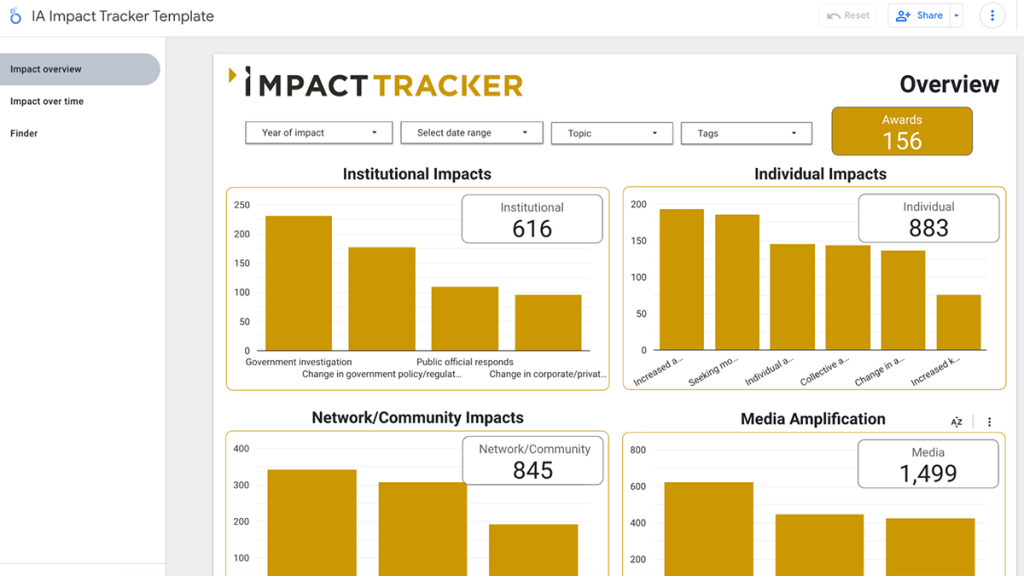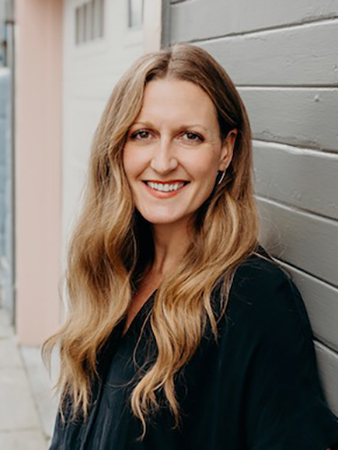
Behind the IA Impact Tracker
A conversation with Lindsay Green-Barber of Impact Architects
A positive development we’ve seen evolve in the past few years in local and community-centered journalism is increased focus on impact producing, tracking and transparency. The Detroit Free Press hired impact producers who think about impact from ideation to post-publishing. The Baltimore Banner shared a year-end impact report of positive change they’ve contributed to in their community. We’ve also seen organizations like the Bay City News, whose staff shared their insights on how they’ve used this IA tracker platform that we’re going to dive a little deeper into today.
The IA Impact Tracker is a Google-based template platform that is free and interactive. You can build and customize it to your needs for data driven impact tracking in your newsroom or organization. It provides a template Google form that feeds into a template dashboard, which shows the input from each Google form entry.
It could be used internally to measure interest in specific beats, externally to apply for support and funding or even as a transparency tool to show your community what you’re working towards in your mission. An overview and some FAQs are here, and here is a step-by-step guide, which includes links to the tool itself (an intake form and a dashboard).

I learned a little more about the tool, how it was built and how it’s being utilized in a conversation with its founder, Lindsay Green-Barber.
Duncan: Tell me about what inspired you to create the IA tracker, what started this idea?
Green-Barber: I entered the impact space about 10 years ago at the Center for Investigative Reporting. I was tasked with finding ways to better measure and understand the impact of their investigative reporting. Digital analytics didn’t really tell them very much about the reach of their stories, nevermind the real world change. When you read stories of the impact that their work was having, meaning any change happening out in the real world, some of it was really obvious, like policy change where public officials responded to the reporting. But then there was also reporters who were reporting on, as an example, sexual harassment in the agricultural industry was a story that had just come out by Bernice Yeung, called Rape in the Fields. And the type of impact she saw was much more nuanced and kind of quieter, and it was more of a slow roll of screenings of the film and new community conversations around the issue.
To me, it was: How do you create a system, both to create a framework around the types of impact so you can talk about institutional or policy change, but also about community change, or change at the level of individuals.
Duncan: So that’s how the IA tracker started? What was the first version like?
Green-Barber: That’s when we built an actual workflow process to get all of the information into one place where we could then do analysis and learning around it. At the time I realized different reporters had their own process, where they’re saving stuff, whether it’s an email folder, or a printed out paper folder, or a Word doc, or sometimes spreadsheets.
So my idea was to create one central repository where they could share it all. I could then again be a partner in that learning and analysis. We used an internal workflow tool originally, and then there was outside interest in the tool. So we invested in creating a custom platform that other newsrooms could use, and that was the original impact tracker. And the idea was (and is), to have a web form that takes less than 30 seconds for a reporter to fill out. And everything goes into a centralized database that everyone has access to. Then when it’s time to do a follow up story, or submit an award application, you go into the database and you can basically filter for just the impact of your project or your story or a specific need.
Duncan: And you recently launched a new version in the past few weeks. How has it changed?
Green-Barber: We did a bunch of user testing and interviews and just found that the platform it was on was not customizable enough. So we looked at the other tools available, and decided that a Google product was free, which made it really accessible, and people have lots of experience with Google Forms so it was something people were already familiar with using.
Duncan: For newsrooms who aren’t sure what amount of time they need to have for this, how long do you recommend they set aside to set up their tracker?
Green-Barber: So if we’re just talking about the impact tracker — how long does it take you to go in and copy the AI general form, set up your own form, create a copy of the dashboard, link it up — you’re probably talking an hour from start to finish. If you go through the step by step guide we provide, you’re just cloning the general impact tracker we built for your use without much customization.
Now if you’re doing pre-work before you get there, then you’re considering, what is the impact framework for my newsroom? What is the type of impact that we care about? Then you’re going to customize that general template to your newsroom based on the pre-work that went into those decisions. We see that pre-work takes 90 minute workshops or longer. That depends on your process and goals.
The tech piece itself is pretty easy. I think it’s everything that goes around it that is tricky.
Duncan: I saw you provide ideas in the template of how they can measure impact. Change in attitude, opinion, increased knowledge. In your experience, how do reporters know when someone has changed their attitude or opinion? Is it just if they run into someone in the community who says that? From emails? How can we measure that consistently?
Green-Barber: I think some of it is just that organic feedback that folks are getting. So it may just be that reporters get emails after the fact, or voicemails, or they run into somebody. And those are all things that, well, they might be one-offs, but I think it’s still valuable to pay attention to. That’s somebody taking time to go out of their way to communicate that something was really powerful to them.
For individual level stuff on a project, or by project or story basis or beat basis, that’s where we’d also urge people to think about beyond that kind of tracking, what else might you do? And often it’s answered by saying, let’s directly ask the audience. So what kind of survey might you have? Maybe a webinar event? How can you build in questions you want answers to?
The impact tracker is not going to answer every question you have, but I think it’s really helpful if we’re getting some directionality around what kind of impact different stories are having.
And then that’s where you might want to invest more resources and do deeper learning.
Duncan: So for smaller newsrooms who don’t have web teams or people dedicated to tracking/measuring/paying attention to impact, what is your advice for them?
Green-Barber: I think it’s about putting it in the context of what your newsroom’s priorities are. It can be a one-person newsroom. What is your mission? What are your goals? And then how does this tool (or any other!) help you understand if you’re making progress towards those goals? And then what kind of data or information do you need to know to see if you’re making progress — focus on that.
Duncan: Could you tell me a little bit about newsrooms who have benefited from using this and what that has looked like for them?
Green-Barber: We have, I think it’s about 15 organizations now, that are on some version of this.
And what we’ve heard that’s great is that the Google platform is (as we hoped) really customizable. So for some organizations, not only are they tracking their impact in news, but they’re able to bring in data on organizational statistics to increase funding and support. They’re able to build an integration with their Salesforce, so they can see that in the same place. Same with getting their Google Analytics there. Newsrooms are integrating it into their other platforms and analytics.
Duncan: Does anyone use the impact tracker in a way that surprised you?
Green-Barber: I think what’s really interesting to me is organizations, especially those that are focused on serving very specific communities, are saying “how can we embed the dashboard in our website? What data do we think we not only want to report back in an annual report or in follow up reporting, but we want to be so transparent that people can see it in real time on our site?” I hear those conversations happening. And I think that the idea about transparency around impact is really important and showing your audience your progress towards the mission, and the value you bring to a community. That, I think, is really powerful.
Duncan: Have you seen any orgs use the data from the tracker to change the way they do something? Have you seen it influence change within the newsroom?
Green-Barber: I think having this information, it often gives you a way to validate the work that’s already happening. In some cases, I do think you have a clear mission, and then you’re doing impact reporting because then you can make sure you’re fulfilling that mission. But other times, we’re making decisions in news meetings and editorial meetings based on underlying assumptions and values that we don’t always explicate. So we might think this is a good story, but then the impact data shows readers weren’t that into it. Having a clear sense of what the mission of your organization is — plus the data — means organizations can make, hopefully, values and mission aligned decisions around editorial, too.
Duncan: What do you see as the future for this tool? Do you feel like you’re going to keep building upon it?
Green-Barber: One of the things we’re hoping to be able to do in this new iteration is that we have a contract with the Gates Foundation that allows us to work with their grantees. That is allowing us to do some community building around the tool that will support their grantees, but also support others in the field more broadly. Our goal is to build out the new member area to have resources where people can share how they’re using it, integrations they’ve made — share that back with the community so folks can get great ideas for how others are using the platform. We see it as something that is going to constantly be evolving and changing and hopefully improving, and that one of the roles we can play is to help connect folks to each other. So I think the future of the tool itself is hopefully bright and going to be interesting and varied. And that a lot of what it does is going to be driven by how newsrooms are using it.
This interview has been edited for length and clarity.

Comments